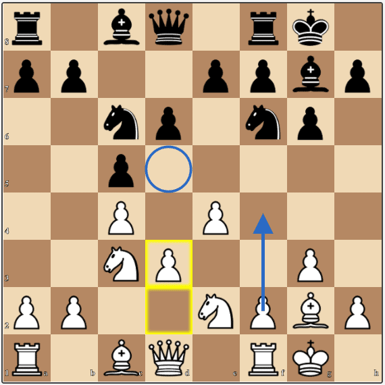Command in the English Opening (1.c4) will take your chess to the next level
The English Opening (1.c4) has been a favoured opening for many renowned chess players due to its flexibility and transpositional possibilities, offering both aggressive and positional styles.
Nagarajan P
11/16/20245 min read


The English Opening is a versatile and strategic chess opening that starts with the move 1. c4, aiming to control the center from the flanks rather than directly occupying it. This opening is favored for its flexibility, allowing White to transpose into a variety of positions, including the Symmetrical Variation, the Reversed Sicilian, and the King's Indian Attack, among others. It offers both tactical and positional play, with a focus on creating a solid yet dynamic pawn structure. Famous players like Garry Kasparov, Bobby Fischer, and Magnus Carlsen have successfully used the English Opening in their games, demonstrating its effectiveness at all levels of play. By avoiding the main lines of other openings, it provides White with a degree of surprise and complexity, often leading to rich and unique middlegame positions. The English Opening is ideal for players seeking a less direct but highly flexible approach to the game.
Comprehensive List of English Opening Variations
Symmetrical Variation
Moves: 1.c4 c5
Players: Garry Kasparov, Magnus Carlsen
Outcome: Balanced, with flexibility to prepare center strikes.
Four Knights Variation
Botvinnik System
Moves: 1.c4 c5 2.Nf3 Nf6 3.g3
Players: Mikhail Botvinnik, Viswanathan Anand
Outcome: Closed with potential for central pawn breaks.
Reversed Sicilian
Moves: 1.c4 e5
Players: Levon Aronian, Boris Spassky
Outcome: Aggressive, mirroring the Sicilian with an extra tempo.
Anglo-Indian Defense
Moves: 1.c4 Nf6
Players: Vladimir Kramnik, Alexander Grischuk
Outcome: Strategic, transposing to Nimzo-Indian setups.
Mikenas-Carls Variation
Moves: 1.c4 Nf6 2.Nc3 d5
Players: Vladas Mikenas, Magnus Carlsen
Outcome: Active play for Black with central control.
Keres Variation
Moves: 1.c4 e6 2.Nc3 d5
Players: Paul Keres, Tigran Petrosian
Outcome: Solid, leading to Queen’s Gambit structures.
King’s English Variation
Moves: 1.c4 e5 2.Nc3 Nc6 3.g3
Players: Nigel Short, Garry Kasparov
Outcome: Flexible with opportunities for flank attacks.
Reverse Dragon
Moves: 1.c4 e5 2.Nc3 Nc6 3.g3 g6
Players: Hikaru Nakamura, Veselin Topalov
Outcome: Tactical, resembling the Sicilian Dragon.
Rubinstein System
Petrosian Variation
Moves: 1.c4 Nf6 2.Nc3 g6 3.e4
Players: Tigran Petrosian
Outcome: Resembles King’s Indian Defense; dynamic play.
Anglo-Grunfeld
Moves: 1.c4 Nf6 2.Nc3 d5
Players: Fabiano Caruana, Peter Svidler
Outcome: Transposes to a Grunfeld, with central pressure.
English Defense Variation
Moves: 1.c4 b6
Players: Bent Larsen, Ulf Andersson
Outcome: Slower play with queenside fianchetto ideas.
Reverse Alekhine
Moves: 1.c4 Nf6 2.Nc3 d5 3.cxd5 Nxd5 4.e4
Players: Alexander Alekhine, Magnus Carlsen
Outcome: Tactical, with complex central play.
English Rat
Moves: 1.c4 d6 2.Nc3 e5
Players: Boris Spassky, Tony Miles
Outcome: Flexible, allowing for varied pawn breaks.
Romanishin Variation
Moves: 1.c4 Nf6 2.Nc3 e6 3.e4
Players: Oleg Romanishin
Outcome: Aggressive, supporting a strong center.
Adorjan Variation
Moves: 1.c4 g6 2.d4 Bg7 3.Nc3 d6 4.e4 e5
Players: Andras Adorjan
Outcome: Double-edged, with tactical complexity.
Flohr-Mikenas Attack
Moves: 1.c4 Nf6 2.Nc3 e6 3.e4 Bb4
Players: Salo Flohr, Vladas Mikenas
Outcome: Leads to open play with early piece activity.
Averbakh System
Karpov Variation
Anglo-Grunfeld
Moves: 1.c4 Nf6 2.Nc3 d5 3.cxd5 Nxd5 4.g3
Players: Bobby Fischer, Peter Leko
Outcome: Counterplay against the center, similar to Grunfeld.
Sniper Variation
Reti–English Hybrid
Pseudo-Grunfeld
Moves: 1.c4 Nf6 2.Nc3 g6 3.d4 d5
Players: Garry Kasparov
Outcome: Tactical with pawn tension in the center.
English Pterodactyl Defense
Reti Gambit Declined
Moves: 1.c4 e5 2.Nc3 d5 3.cxd5 Nf6
Players: Richard Reti
Outcome: Central complexity; tactical possibilities.
Queen’s English
Moves: 1.c4 e5 2.Nc3 Bb4
Players: Mihai Suba
Outcome: Open play, aiming for dynamic counterplay.
Two Knights System
Reverse Maroczy Bind
Moves: 1.c4 e5 2.Nc3 Nf6 3.g3 c5
Players: Tigran Petrosian
Outcome: Strategic, akin to the Maroczy Bind in Sicilian.
Neo-Catalan
English-Indian Defense
Moves: 1.c4 Nf6 2.Nf3 b6
Players: Alexander Grischuk
Outcome: Balanced; Black has flexible pawn setups.
Anti-Grunfeld
Moves: 1.c4 Nf6 2.Nc3 d5 3.cxd5 Nxd5 4.e4 Nxc3 5.bxc3
Players: Alexander Alekhine
Outcome: Tactical with active piece play.
Karpov System
Players: Anatoly Karpov
Outcome: Solid setup with flexible plans, often leading to slow, strategic maneuvering with an emphasis on central control
Levenfish Attack
Players: Lev Polugaevsky, Boris Spassky
Outcome: Aiming for a kingside attack with fianchettoed bishop and rapid development, leading to dynamic positions
Fianchetto Variation
Moves: 1.c4 Nf6 2.Nc3 g6 3.g3
Players: Garry Kasparov, Viswanathan Anand
Outcome: White develops a strong control over the central and long diagonals, while Black looks for counterplay on the queenside
Hedgehog System
Players: Garry Kasparov, Vladimir Kramnik
Outcome: Black adopts a flexible pawn structure aiming for a counterattack, while White tries to expand on the queenside
Hedgehog Variation
Moves: 1.c4 e5 2.Nc3 Nf6 3.g3 d5 4.cxd5 Nxd5 5.Bg2 Be7 6.Nf3 O-O
Players: Garry Kasparov, Bobby Fischer
Outcome: A highly tactical system, with pawn structures like the Hedgehog providing counterattacking opportunities for both sides
Knight Variation
Players: Bobby Fischer, Mikhail Tal
Outcome: Leads to flexible, strategic development with both players looking to control the center and expand
Moscow Variation
Players: Vladimir Kramnik, Garry Kasparov
Outcome: This variation aims for the development of the light-squared bishop early, often leading to long-term maneuvering and strategic battles
Zukertort Variation
Players: Johannes Zukertort, Alekhine
Outcome: Balanced development; Black tries for solid but flexible play, while White develops quietly to dominate the long diagonals
Breyer Variation
